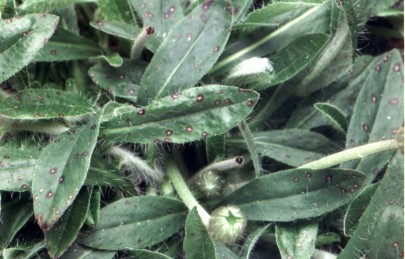Hieracium rust
History in New Zealand
The hieracium rust was first noticed here in 1995 on mouse-ear hawkweed (Pilosella officinarum) plants collected from Molesworth Station. It is not known how the rust came to be established in New Zealand. At the time of the discovery, researchers were studying the rust in Europe to see if it would be suitable to import as a classical biological control agent. Subsequent studies showed that mouse-ear hawkweed populations vary in their susceptibility to the rust, and many are resistant to this particular strain. Another two strains of the rust have since been imported from Ireland to improve the level of attack. As a result of natural dispersal by wind and human intervention, the rust now occurs throughout all hawkweed-infested parts of the country, so no further effort is required to spread it around.
How would I find/recognise it and what is its lifecycle?
It may be possible to see rust symptoms at any time of the year. If you are searching in autumn or spring, then look for rusty-coloured spores on the upper surface of the leaves (pustules containing spores develop inside leaves and eventually burst out through the top). If you are looking in summer, then keep an eye out for small black pock marks, which are the scars made by pustules. The first sign of infection can be yellow flecks on the leaves.
Image: brown hieracium rust pustules.

Image: small black pock marks made by hieracium rust pustules.
Another pathogen that you are likely to see on mouse-ear hawkweed is a powdery mildew (Erysiphe cichoracearum), which attacks many members of the Asteraceae (daisy) family. You are unlikely to confuse this mildew with the hieracium rust because infected leaves have a powdery whitish appearance and there is no black scarring. After heavy mildew attack, the leaves may become pale red in colour, but this can also happen anytime the plant is under stress.
How does it damage hawkweeds?
The rust feeds and grows inside the leaves. It can only develop on living tissue (i.e. it is an obligate parasite). The fungus performs best under moist conditions, but its impact can be most severe when infection is followed by drought.
Will it attack other plants?
No, it is extremely unlikely that the hieracium rust will damage anything other than mouse-ear hawkweed (Pilosella officinarum). Even other closely related hawkweeds are unlikely to be attacked. Two other varieties of this rust P. hieracii var. hieracii and P. hieracii var. hypochoeridis are also present in New Zealand. They are found on a range of hosts including dandelion, catsear, and chicory.
How effective is it?
A field study has suggested that the growth of infested plants may be suppressed by around 10-20%.
How can I get the most out of it?
The hieracium rust is widely established so there is little to gain by spreading it around further.


